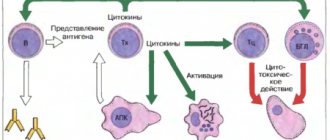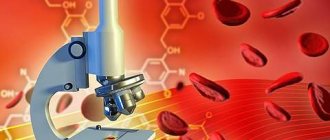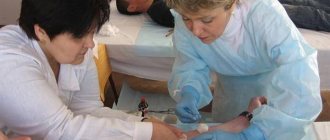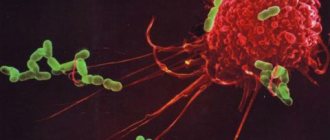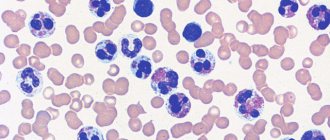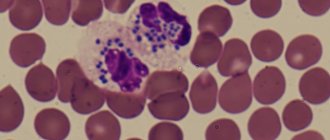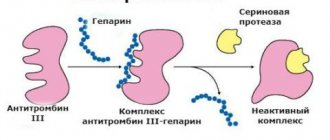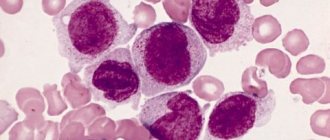Elevated platelets in a child: causes of pathology, what parents should do
At any hint of illness, many mothers rush to show their baby to the pediatrician.
And the younger the child, the more they rush. The doctor will examine the baby, listen to him and... send him for a general blood test. Because it is the hematogram (the ratio of blood cells, their quantity) that in most cases gives a good specialist a complete understanding of what is happening in the child’s body. But for mothers, the names and numbers on a small piece of paper in a children’s card remain a meaningless combination of symbols. The simplest thing a mother can figure out on this piece of paper is the platelet count.
But this knowledge will help parents prevent any complications associated with changes in their blood levels. What are platelets, and how many of them should “float” in the baby’s bloodstream? What to do and how to react if the number of platelets in the blood is increased in a child under the age of one year, at 2 or 3 years old? Why are these changes happening? We will look into these issues!
Basophils are elevated - an alarming symptom
Basophils are specific blood cells that are produced by the hematopoietic granulocyte lineage. Basophils are included in the category of granulocytes. From the bone marrow they enter the bloodstream and remain in free circulation for three to four hours, after which they are introduced into the tissues, where they live for 10-12 days. There are few basophils, their percentage in the blood is 0.5-1.0%, accurate calculation is possible with leukocyte analysis.
Basophil function
If basophils are elevated, this means that an inflammatory process has begun in the body. An increase in basophil levels is considered an important diagnostic criterion. Once at the site of inflammation, basophils open up and begin to release active substances: heparin, histamine and serotonin. The function of basophils is focused on immediate response, for example, in case of anaphylactic shock. But in conjunction with lymphocytes, basophils can also participate in slow reactions. If basophils are constantly elevated, this condition of the body is called basophilia. In an adult, their level can reach 2-3% and this does not cause concern, but if the level increases further, an urgent examination should be performed to diagnose the disease. It must be remembered that basophils are activated during any allergic reaction of the body. In addition, basophilia is a sure sign of circulatory system disease in acute leukemia, polycythymia and chronic myeloid leukemia.
Cell interaction
The percentage of basophils increases while taking hormonal drugs. Hemolytic anemia is also accompanied by basophilia. But if lymphocytes and basophils are elevated, then this is most likely a mixed process, when the body’s immune system is affected during acute inflammation. In this case, there is a systematic interaction between cells aimed at eliminating harmful agents. The same thing happens when basophils and monocytes are elevated at the same time. Cells unite to solve a common problem. Unlike fast-reacting basophils, monocytes and lymphocytes are measured in their actions, since their purpose is to participate in the processes occurring in the body’s immune system. If the level of monocytes and lymphocytes increases, basophils will also be increased. However, the direction of action of cells is different. The immune system is responsible for neutralizing and counteracting harmful external agents, bacteria, viruses, and antigen parasites.
Destruction of antigens
Phagocytosis and antibody production occurs. The process involves granulocytes, including basophils and neutrophils, monocytes and lymphocytes. The quantitative content of cells is shown by a routine blood test. The main phagocytic cells are monocytes. They are produced in the bone marrow and then located in local areas attacked by antigens. At this stage, lymphocytes begin to interact with monocytes, which produce antibodies. This function lies with group B lymphocytes. T lymphocytes directly destroy antigens. But the most effective antigen neutralizers are 0-lymphocytes, which identify and destroy absolutely all harmful agents. When monocytes, lymphocytes and basophils are elevated, a tumor process is most likely occurring in the body.
Monocytosis
Monocytes are classified separately. As their number increases, absolute or relative monocytosis begins, depending on the severity of the disease. A low level of leukocytes and neutrophils characterizes relative monocytosis. Active inflammatory processes or purulent infections are absolute monocytosis. Monocytosis in any form indicates that stimulation of the production of tissue macrophages has entered an active phase.
fb.ru
Platelet norms
First, let's find out what kind of cells these are - platelets. And these are the formed elements of blood. Some of the types. Honestly, these are the smallest inhabitants of the bloodstream, they are even called blood platelets - they are so small and flat. The plates have many functions, this is how the body works - even the tiniest cell has a lot of responsibilities and tasks. The main job of platelets is to gather in close, cozy companies, forming a blood clot.
In order for all these processes to occur on their own, it is necessary that the number of blood platelets more or less correspond to the norms generally accepted for different ages:
| Age | Normal platelet count (units per 1 liter of blood) |
| Newborns | 100-420*109 |
| From 10 days to a year | 150-350*109 |
| Over a year old | 180-320*109 |
| Boys over 14 years old | 180-320*109 |
| Girls over 14 years old | 150-380*109 |
What are basophils in a blood test?
Basophils are a subpopulation of white blood cells. A distinctive feature is the ability of the core to absorb the main dye. This ability makes it easy to differentiate basophils from other cells in the blood.
Recall that eosinophilic granulocytes stain intensely pink, and neutrophils absorb acidic and basic dyes.
Due to the high content of histamine granules, leukotrienes, prostaglandins and other mediators of allergic reactions, the nucleus in the cytoplasm is practically indistinguishable. In comparative terms, the cell sizes are significantly larger than representatives of other subpopulations of leukocytes: neutrophils and eosinophils.
Why are basophils needed?
Basophils were originally thought to act as precursors of mast cells in the blood. The basis for this statement was their morphological and functional similarity. Both types of cells contain granules and allergy mediators in the cytoplasm. And upon contact with class E immunoglobulins, histamine is released.
However, a detailed study of the cells refuted this assumption. It has been established that basophils enter the blood from the bone marrow already mature. At the same time, mast cells mature in the human systemic bloodstream and only after that penetrate into tissue cells. It is only fair to say that these two types of cells are related.
The main role of basophils: participation in the development of an allergic reaction - anaphylaxis. It occurs against the background of repeated contact of a person with a substance to which he shows individual intolerance. The incidence of deaths reaches 20%. In this case, basophils in the blood are increased to critical levels.
The mechanism of the protective reaction is based on the ability to quickly destroy basophilic granulocytes and release their cellular contents. Upon contact with the antigen-antibody complex, cell dissolution also occurs.
Allergic reaction mediators enter the blood in large quantities, which trigger a typical immune response. The protective mechanism allows you to block the spread of toxins through organs and tissues in the human body. A natural influx of fluids with various types of leukocytes occurs at the site of localization.
Another feature is the ability to penetrate through the walls of blood vessels beyond their limits and further exist in the tissues of organs. In this case, basophils become full-fledged tissue mast cells.
There is information about their phagocytic activity and the ability to move when exposed to a chemical stimulus. However, under natural conditions, the implementation of this function is minimized.
What do deviations from the norm indicate?
If the baby’s platelet count fits into generally accepted norms, that’s good. However, if there is a significant deviation (more than 100 * 109 units per 1 liter of blood), the child may be diagnosed with thrombocytopenia (this is if the amount is below normal) or thrombocytosis (when there are too many blood platelets).
Thrombocytosis poses a much greater danger. If the analysis shows that the child has a high platelet count in the blood, this indicates the following:
- The blood is thicker than normal. This overloads the blood vessels and heart - it is more difficult for these organs to “pump” fluid throughout the body.
- The platelets are too close to each other. This is the danger of their involuntary combination into quite large blood clots, which can clog blood vessels and in some cases even stop the heart, clogging any heart valve or coronary vessel.
- Even the combination of blood platelets into small blood clots is fraught with blockage of microcapillaries. This provokes various edema, as well as infarctions in parenchymal organs, destroying their structure (liver, lungs, spleen, kidneys). Even the baby’s brain gets damaged (in advanced cases).
Norm and common factors of high content in children
Little girl blows her nose, isolated over white
Like adults, basophilic bodies in children perform the same functions. They are active in the body's immune response to various types of stimuli. The percentage of basophils in recently born children is 0.4-0.9%. But this figure is gradually decreasing, and for a long period it remains at around 0.6-0.7%. The norm for adults is restored by the age of 21 and should be 0.5-1%.
In children, BAS increases with various recurrent and acute diseases, during allergies and against the background of the development of blood cancer. If the jumps in indicators are significant and persist for a long time, then the following pathologies can be suspected:
- Myeloid leukemia;
- Worm infestation;
- Infections (eg, chickenpox);
- Diseases of the hematopoietic system;
- Inflammations of various nature;
- Allergies.
Basophilia also occurs with thyroid dysfunction and minor body irradiation. A pediatrician can diagnose the exact reason why abnormalities in the blood flow test occur. The leukocyte formula alone is not enough to make a diagnosis. The child must be examined by an oncologist, endocrinologist, infectious disease specialist and allergist. Only after such an extensive diagnosis is it possible not only to find out the cause of the disorders, but also to prescribe effective therapy.
Reasons for deviations
Why and for what reasons does the number of platelets in a child’s blood increase? There are several factors that precede an increase in blood platelets in the baby’s bloodstream:
- Hereditary or acquired pathologies of the blood system. These include erythremia, myeloid leukemia and thrombocythemia.
- Pathologies of infectious nature. Such diseases include meningitis of various etiologies, inflammatory processes, toxicoplasmosis, hepatitis, parasitic and fungal infections, encephalitis, and viral diseases.
- Stress and hormonal disorders. During the period of accelerated growth (up to 12 years), the body develops rapidly. Failures in the hormonal system affect the number of blood platelets, their formation and breakdown.
Elevated lymphocyte counts
Lymphocytes increase in the blood quite often. And this will not necessarily indicate pathology. Some metabolic processes, the body's reaction to the influence of internal and external stimuli, are also accompanied by an increase in these cells.
So in women, an increase is observed during menstruation. Prolonged fasting does the same. And even neurasthenia can be a cause. Occurs in children under four years of age who are not ill.
But more often, lymphocytosis (an increase in lymphocytes) is observed when exposed to a pathological agent: viral or bacterial infection, allergy, lymphoid sarcoma, diseases of the endocrine organs, etc.
Useful tips
It is quite difficult to determine thrombocytosis from the clinical picture - this pathology does not have pronounced symptoms. In a child, an increased platelet count often occurs in combination with an increased ESR (erythrocyte sedimentation rate) and is clinically manifested:
- Headaches;
- Fatigue;
- General weakness.
In order to respond to this pathology in a timely and correct manner, you need to follow simple tips:
- At the slightest suspicion, take the child to the doctor;
- Be sure to take a finger prick blood test;
- Together with your doctor, determine the cause of the increase in platelets;
- Following the doctor's recommendations, undergo a course of treatment.
Deviations towards increase
Observed when:
If there is tuberculosis in the body, at first the level of sedimentation does not change, but if the necessary therapy is not carried out in time, and the pathology is complemented by complications, then the red blood cells settle faster and the rate increases.
If a viral infection enters the body, which occurs in the acute stage, then from the second day the ESR rises sharply and may not decrease for a long time. This indicator is typical for pneumonia; even if the acute condition is relieved, the level of erythrocyte sedimentation rate still remains elevated for a long time.
In acute appendicitis, the ESR does not increase on the first day, and then increases sharply.
ESR in rheumatoid arthritis also increases, but does not significantly exceed normal limits.
In diseases of the thyroid gland, the level of ESR can behave differently. It all depends on how the body copes with the inflammatory process. Over a long period, the level may increase if the disease has reached a chronic stage.
If the ESR level increased and then decreased by itself, this means that the immune system was able to cope with the disease.
Increased limits can be observed in iron deficiency anemia. At the same time, often, the level of hemoglobin in the blood falls, and an increase in ESR is a symptom of the presence of several diseases in the patient’s body.
With gout, an acute inflammatory process develops, which negatively affects the entire body and leads to an increase in the indicator.
The ESR level may also increase if there is viral hepatitis in the body. In parallel with this, symptoms of anemia may appear, bilirubin in the blood increases, and other indicators change. On palpation, an enlargement of the liver or spleen is observed; the patient may complain of pain and yellowing of the skin.
If a patient has chronic tonsillitis, a blood test may reveal an increased level of leukocytes and ESR.
ESR in cancer
High levels of erythrocyte sedimentation rate are observed in tumors. Oncology provokes changes in the composition of the blood. This happens especially often if the reproductive system, pancreas, respiratory organs, and kidneys are affected.
ESR can increase to levels from 60 to 80 mm per hour in the presence of fibroids, lymphosarcoma and other malignant tumors in the body.
Often, an elevated erythrocyte sedimentation rate may indicate the spread of metastases in the patient’s body.
How do red blood cells behave after a course of chemotherapy? It is worth remembering that such treatment has many side effects for hematopoiesis, because elements of the biological fluid are damaged.
Often, after the procedures performed, a person begins to become anemic, the number of red blood cells decreases, and the ESR increases.
ESR and HIV infection
What does a blood test show for AIDS and HIV infection? Often, with this disease, the patient’s ESR does not increase for several years and is no different from the level of a usually healthy person. But suddenly the patient's subsidence rate rises to abnormally high rates. But you should not immediately suspect that you have HIV infection, because other diseases, for example, rheumatism or an impending heart attack, can give similar ESR indicators.
Analysis and allergies
Often a person gets scared when the attending physician tells him about an increase in the level of erythrocyte sedimentation rate, but it is worth remembering that if a person has allergies or is taking medications against allergens, the results of the analysis can be distorted. Such a study conducted by a laboratory assistant may not indicate that the person has serious health problems.
When the ESR level increases, the doctor does not prescribe specific treatment, but the patient is subjected to additional examination, on the basis of which a diagnosis is made and appropriate treatment is prescribed.
This therapy helps eliminate the pathology.
C-section
If delivery is impossible in the usual way, the fetus is removed by caesarean section. This is a surgical intervention, which can be either planned or emergency; it is worth remembering that recovery can take up to 2 months, and the surgical site is an excellent environment for infection.
The inflammatory process increases the erythrocyte sedimentation rate and increases leukocytes in the blood.
Increased level of platelets in the blood of a child - video
This video explains in detail what happens when the number of blood platelets in a child changes, almost all the causes of thrombocytosis and thrombocytopenia are listed.
Blood is the most important fluid in our body. By the slightest changes in its composition, you can find out whether everything is fine with the child. One of the important elements of this fluid are platelets.
An increased content of blood platelets not only indicates the presence of another disease in the body, but in some cases it is also dangerous for the baby’s life. Thrombocytosis is just a symptom of an underlying disease or pathology , but if you do not treat it carefully and take action, serious complications are possible. That is why, at the slightest suspicion, you should immediately contact specialists.
source
Hemoglobin and red blood cells
Another important blood indicator is hemoglobin. There are cases when hemoglobin decreases along with platelets. Often the analysis shows deviations during pregnancy and childbirth. Hemoglobin in such cases becomes lower, which is explained quite simply. A large amount of iron and folic acid is sent to the baby’s body, so the mother’s hemoglobin inevitably decreases. That is why during pregnancy, proper nutrition with additional amounts of various microelements and substances is of great importance.
Reduced or increased hemoglobin may be a sign of a serious illness. In particular, when the analysis revealed low hemoglobin, it is necessary to exclude thalassemia, aplastic anemia, and blood diseases.
Quite often, hemoglobin is reduced in diseases of the bone marrow, which cannot function correctly. Accordingly, blood cells are produced in insufficient quantities. As a result, not only hemoglobin decreases, but also:
Red blood cells are also an important component of blood. Normally, the analysis of an adult should show an indicator of approximately five million red blood cells per 1 mm³ of blood. Red blood cells in the body carry oxygen and carbon dioxide. When red blood cells are elevated, this often means the presence of leukemia, congenital heart defects or chronic pulmonary diseases.
Normal ESR in the blood of children and what to do if the value is elevated
Thanks to a child's blood test, you can determine whether the baby is healthy or has any diseases. This is especially important if the disease is hidden. To identify such hidden pathologies, all children are routinely sent for tests at a certain age. And increased attention is paid to blood tests in children.
One of the important indicators determined in the laboratory during blood testing is ESR. Seeing this abbreviation on a blood test form, many parents do not know what it means. If, in addition, the analysis revealed an increased ESR in the child’s blood, this causes worry and anxiety. To know what to do with such changes, you need to understand how ESR analysis is carried out in children and how its results are deciphered.
Moderately elevated basophils in adults: physiological factors
Slight deviations in white blood cell counts can occur with various external or internal changes. Since basophils suppress and block not only allergens, but also other foreign bodies, and also take part in regulating the permeability and tone of capillaries, any disturbances slightly increase the values.
Increased levels are observed when exposed to the following physiological factors:
- Recovery after an infectious disease;
- Taking hormonal drugs with estrogen;
- Radiation in small doses (found in doctors’ x-ray rooms);
- Iron deficiency;
- Increased production of estrogen in a woman (menstrual cycle, ovulation);
- Poor nutrition.
In any case, even a moderate increase in indicators should alert the patient. It is necessary to undergo an examination to prevent the development of a serious disease. If the increase in BAS is temporary and is not associated with pathologies, then there is no need to worry about your health.
High basophilic cells in an adult facing periodic relapses of a chronic disease indicate an exacerbation of the process and an increased fight of the body against foreign particles and the inflammatory process.
What is ESR and how is its value determined?
The abbreviation ESR abbreviates the “erythrocyte sedimentation rate,” which is found during a clinical blood test. The indicator is measured in millimeters per hour. To determine it, blood combined with an anticoagulant (it is important that it remains liquid) is left in a test tube, allowing its cells to settle under the influence of gravity. After one hour, the height of the upper layer is measured - the transparent part of the blood (plasma) above the blood cells that have settled down.
Clinical manifestations of anaphylaxis and emergency case - shock
Clinically, an allergic (anaphylactic) reaction can manifest itself:
- Anaphylactic shock, which is one of the most severe manifestations of allergies (loss of consciousness, drop in blood pressure) and requires immediate medical attention;
- An attack of suffocation in asthmatic patients;
- Continuous sneezing and swelling of the nasal mucosa (rhinitis);
- The appearance of a rash ().
Obviously, the body's fastest response to the arrival of a foreign antigen is anaphylactic shock. The onset time is seconds. Many people have witnessed or experienced cases where an insect bite (usually a bee) or the administration of medications (usually novocaine in a dental office) caused a sharp drop in pressure, which created a threat to life. This is anaphylactic shock, which a person who has experienced such horror should remember for the rest of his life, because the second case will develop even more rapidly. However, each subsequent response is more severe than the previous one - after all, the antibodies are already there. And it’s good if there is an anti-shock first aid kit with adrenaline and glucocorticoids nearby...
Step 2: after payment, ask your question in the form below ↓
Don't forget to include the payment code at the end of the question!
(otherwise they will not be able to identify you) Paid questions are usually processed within 48 hours Step 3:
You can additionally thank the specialist with another payment for an arbitrary amount
Despite the low content of basophils in the blood, they perform important functions for the body. They belong to leukocytes and participate in the formation of inflammatory and allergic reactions, releasing active substances contained in their granules. They take part in delayed-type reactions and immediate hypersensitivity reactions. cause immediate allergic reactions such as anaphylactic shock, rhinitis, and some types of asthma. They react especially quickly when soft tissue is damaged. When bitten by bees, wasps and other insects, as well as snakes, they block the action of the poison and prevent it from spreading, then remove it.
This is what basophilia looks like on a blood smear
- of the total number of leukocytes - from 0.5 to 1%;
- absolute level - 0.01-0.065X10⁹ per liter of blood.
It is believed that basophils are elevated if their content in the blood exceeds 0.2X10⁹ per liter or in the leukocyte formula their percentage has increased to 3. The level of basophils in the blood does not increase as often as the level of other leukocytes. If this happens, it means that a pathological process cannot be excluded, but the increase is not always associated with the disease.
Table of norm values
When a blood test is deciphered, all indicators are compared with standards, which depend on the age of the children. This also applies to the sedimentation rate of red blood cells, because the ESR immediately after birth will be the same, at the age of 2-3 years or 8-9 years the indicator will be different.
The normal ESR results are:
In a newborn in the first days of life
In an infant up to one year old
In children older than one year
An increase in the rate between the 27th day of life and two years is considered normal. In children of this age, ESR can reach 12-17 mm/h. In adolescence, the results differ for girls (an indicator of up to 14 mm per hour is considered normal) and for boys (an ESR of 2-11 mm per hour is considered normal).
Indicators and standards
When diagnosing pneumonia in children, an important point is a blood test. For example, knowing the indicators of leukocytes and lymphocytes, you can determine the etiology of the disease: viral or bacterial.
The most significant in diagnosing pneumonia are serological, biochemical and general blood tests. Let's look at each of them in more detail.
Determination of the etiology of the disease by blood parameters
Serological
Allows you to quickly identify microorganisms and infectious agents in cases where the results of other tests are called into question. It is done quite rarely. It is used to diagnose atypical pneumonia caused by chlamydia or mycoplasma. This study makes it possible to determine what was the source of the disease and correctly prescribe a course of antibiotics for treatment.
Polymerase chain reaction (PCR)
This test is the most effective tool for identifying atypical pathogens and viruses (mycoplasma, chlamydia). The study allows you to determine the DNA of any microorganism. The advantage is the ability to quantify the microbe in the body and the ability to detect several infections or viruses at once.
Enzyme-linked immunosorbent assay (ELISA)
Unlike PCR, this test does not detect viral agents or bacteria, but measures the amount of antibodies produced by the human immune system. Antibodies, in turn, fight the pathogen. For example, in the first 10 days of illness, the test shows the presence of class “M” immunoglobulins, later with the development of the disease – class “A”. A protracted course of infection may be indicated by the body’s production of class “G” immunoglobulins.
Biochemical
It is of great importance in diagnosing the disease. Blood biochemistry indicators are nonspecific, but enable the doctor to determine the severity of the inflammatory process and the functional activity of internal organs during pneumonia.
It is important to pay attention to the following blood parameters:
- Total protein. In the normal state of the body, the protein content is 65-85 g/l. With pneumonia, it does not increase or decrease and is within acceptable limits.
- Alpha and gamma globulin. The value of these indicators significantly exceeds the norm. This is evidence that the body is fighting inflammation.
- Fibrinogen. Slightly exceeds the norm.
- C-reactive protein. This indicator is above the norm.
- Lactate dehydrogenase (LDH). The presented figure is slightly higher than normal.
Biochemical blood test standards
General blood analysis
The CBC has the greatest diagnostic value and contains the following indicators:
- Leukocytes. If bacterial pneumonia is present, the white blood cell count will be higher than normal. With viral pneumonia, there is a significant decrease in the number of leukocytes (leukopenia). In children, the leukocyte norm depends on age. For newborns - 9.2-13.8 x 10 to 9 degrees U/l, from one year to 3 years 6-17 x 10 to 9 degrees U/l, from 3 to 10 years - 6.1-11.4 x 10 to the 9th degree U/l.
- Leukocyte formula and its shift. When the disease is caused by bacteria, pronounced granular neutrophils are found in the blood. A significant amount of their immature (band) forms indicates bacterial pneumonia. This is the so-called shift of the leukocyte formula to the left. When there are few neutrophils in the blood and more lymphocytes than normal, this indicates the viral nature of pneumonia in a child.
- Red blood cells. With a mild course of the disease, their slight decrease is possible; with a more severe degree of pneumonia, the number of red blood cells is increased. The norm of erythrocytes for children up to one year is 4-5.3 x 10 to the 12th power g/l, from one to three years old – 3.7-5.3 x 10 to the 12th power g/l, up to 12 years – 3.7 -5.0 x 10 to 12 degrees g/l
- Lymphocytes. With a reduced number of lymphocytes, we can talk about the bacterial nature of pneumonia.
- Platelets. With pneumonia, they are within acceptable limits characteristic of age.
- Erythrocyte sedimentation rate (ESR).
Norms of general blood test in healthy children
Erythrocyte sedimentation rate (ESR) - norm and deviation
In acute pneumonia, one of the most important signs of the presence of the disease in a child’s body is the erythrocyte sedimentation rate.
In children, this indicator varies depending on age. An increase in ESR is one of the most characteristic signs of pneumonia. At the same time, the erythrocyte sedimentation rate in the child’s blood is increased and can exceed 30 mm/h.
For comparison, ESR norms in children depending on age are as follows:
- for newborns – 2-4 mm/h;
- children under one year old - from 3 to 10 mm/h;
- children aged from one to 5 years - from 5 to 11 mm/h;
- children aged 6-14 years - from 4 to 12 mm/h.
Why is it below normal?
Deviations of ESR from the norm are often manifested by an increase in this indicator, and a decrease in the rate at which red blood cells are deposited is observed much less frequently. The most common cause of such changes is increased blood viscosity.
A lower ESR occurs when:
- Dehydration, for example due to acute intestinal infection.
- Heart defects.
- Sickle anemia.
- Acidosis (lowering blood pH).
- Severe poisoning.
- Sharp weight loss.
- Taking steroid medications.
- An increase in the number of blood cells (polycythemia).
- The presence in the blood of red blood cells with an altered shape (spherocytosis or anisocytosis).
- Pathologies of the liver and gallbladder, especially manifested by hyperbilirubinemia.
What does it mean when basophils are low in an adult?
A moderate decrease in the indicator during therapy for a high content of basophilic granulocytes is a sign of correctly selected treatment methods.
In most cases, a decrease in the level of basophils in the blood has no diagnostic value. The exception is cases when there is a complete absence of basophils and a decrease in all leukocyte cells.
Possible reasons for such changes in the blood:
- exhaustion of the body due to chronic pathologies;
- suppression of the immune system;
- severe physical or emotional stress;
- disruption of the endocrine system and disruption of normal hormonal levels. For example, excess thyroid hormones or anterior pituitary gland;
- side effects from prednisolone treatment;
- decreased hematopoietic function of the bone marrow;
- acute stage of pulmonary inflammation.
If the test results for an adult or child indicate 0 (zero) in the “basophils” column, then this may be a variant of the physiological norm. In the absence of pathological symptoms, the condition does not require medical attention. The required number of basophilic granulocytes is produced by the bone marrow as needed.
Reasons for increasing ESR
A high ESR in a child does not always indicate health problems. This indicator can change under the influence of various factors, sometimes harmless or temporarily affecting the child. However, quite often an increase in ESR is a sign of illness, and sometimes very serious.
Non-hazardous
For such reasons, a slight increase in ESR is typical, for example, up to 20-25 mm/h. This ESR indicator can be detected:
- During teething.
- With hypovitaminosis.
- If your child is taking retinol (vitamin A).
- In case of strong feelings or stress, for example, after a baby has been crying for a long time.
- During a strict diet or fasting.
- When taking certain medications, such as paracetamol.
- For obesity.
- If there is an excess of fatty foods in the diet of a baby or a nursing mother.
- After vaccination against hepatitis B.
In addition, the so-called C syndrome of elevated ESR can be detected in childhood . With it, the indicator is high, but the child does not have any complaints or health problems.
Pathological
In diseases, ESR increases much more than normal, for example, to 45-50 mm/h and higher. One of the main reasons for faster erythrocyte sedimentation is an increase in the amount of protein in the blood due to an increase in the level of fibrinogen and the production of immunoglobulins. This condition occurs during the acute phase of many diseases.
An increase in ESR is observed when:
- Infectious diseases. An increased rate is often diagnosed with bronchitis, ARVI, scarlet fever, sinusitis, rubella, cystitis, pneumonia, mumps, as well as tuberculosis and other infections.
- Poisoning, for example, caused by toxins in food or salts of heavy metals.
- Helminthiasis and giardiasis.
- Anemia or hemoglobinopathies.
- Injuries of both soft tissues and bones. ESR also increases during the recovery period after surgery.
- Allergic reactions. ESR increases both during diathesis and anaphylactic shock.
- Joint diseases.
- Tumor processes, for example, with leukemia or lymphoma.
- Endocrine pathologies, for example, diabetes mellitus or thyrotoxicosis.
- Autoimmune diseases, in particular lupus.
Platelets and lymphocytes are elevated in an adult
Lymphocytes are responsible for recognizing foreign proteins and forming immunological memory, which allows them to resist infections. A condition in which there are elevated lymphocytes in the blood is called lymphocytosis.
The group of lymphocytes is heterogeneous, it includes B-, T-subpopulations and NK cells that have antiviral and antitumor activity.
Properties of lymphocytes
Lymphocytes are one of the populations of leukocytes. Production of this cell population occurs in the bone marrow and thymus during childhood. In the body they accumulate in the spleen, lymph nodes, and liver.
When lymphocytes are elevated, their content exceeds 4 thousand/µl. Lymphocytosis is distinguished:
- reactive – caused by a reaction to the penetration of a foreign protein into the blood;
- malignant - increased lymphocytes in the blood as a result of impaired production in the bone marrow.
Reactive lymphocytosis is characteristic of young people and is manifested by enlarged lymph nodes. The total number of B cells in an adult is 0.19-0.38 thousand/μl, the T-subpopulation is 1.1–1.7 thousand/μl.
Subsets of B cells produce immunoglobulins and are responsible for humoral immunity. Subgroups of helper and suppressor T cells regulate the functioning of all parts of the immune system, and killer T cells destroy cells identified as foreign.
Norm of lymphocytes
To get an idea of the state of immunity, absolute and relative indicators of the concentration of leukocyte populations are used. The absolute value reflects the total number of cells in a given population, and the relative value indicates what proportion of the total leukocytes are lymphocytes.
In adults, absolute lymphocytes are 0.8 - 4 thousand / μl, the relative norm is 19 - 37%. Lymphocytes (lym) are elevated, if their normal levels are exceeded in a general blood test, this means that:
- absolute number above 4 thousand/µl;
- relative lymphocytes – more than 37%.
In this case, relative lymphocytes can be overestimated while the absolute indicators of this population in the blood remain unchanged. There are no differences by gender.
If an adult’s blood tests show significantly elevated lymphocytes, this does not always mean that such a disorder threatens health. A temporary increase in the number of lymphocytes in the blood is observed even in practically healthy people.
In the elderly, there is a slight decrease in lymphocytes. For children, lymphocytes that are elevated by adult standards in a general blood test are a variant of normal values. You can get acquainted with the norms of this population of leukocytes in children on the website here.
Causes of increased lymphocytes
All processes in the body during which destruction of one’s own cells occurs are accompanied by an increase in the level of lymphocytes in the blood. Particularly high levels of lymphocytes in a general blood test are noted:
- for infections when the pathogen is inside its own cell - toxoplasmosis, chlamydia, tuberculosis, whooping cough;
- as a result of autoimmune processes associated with the destruction of one’s own tissues.
The population level increases as the disease transitions from the acute to the chronic phase, as well as when inflammation subsides during the recovery stage.
Physiological deviation from the norm
Increased test results may be caused by:
- smoking;
- physical activity – up to 5 thousand/µl for a short time;
- stress;
- dietary habits - fasting, vitamin B12 deficiency, large amounts of carbohydrates in food;
- high temperature;
- changes in hormonal levels - for example, during menstruation in women;
- reaction to taking medications - hematopoietic stimulants, phenytoin;
- poisoning with heavy metals, arsenic, tetrachloroethane;
- removal of the spleen.
What diseases cause increased lymphocytes?
An increase is observed in diseases:
- infectious, which are provoked by: viruses - ARVI, influenza, mononucleosis, whooping cough, HIV, measles, chickenpox;
- protozoa - toxoplasmosis;
- bacteria – syphilis, brucellosis;
- fungi - tuberculosis;
- parasitic worms;
- lymphocytic leukemia;
- thyrotoxicosis;
- adrenal glands;
A particularly high level of lymphocytes is observed in the blood during measles, chicken pox, rubella and other diseases to which lifelong immunity is developed.
The relative indicator of lymphocytes is increased during influenza, hepatitis, syphilis, and after ARVI - this means that the percentage of this population relative to total leukocytes in adults is higher than 37.
Test results are greatly increased for chronic lymphocytic leukemia, a benign tumor disease that mainly affects men over 65 years of age. The disease develops due to a hereditary predisposition and exists in several forms.
If the disease develops, then many lymphocytes accumulate in the lymph nodes and spleen, the level of which in the leukocyte formula of the blood rises to 70-80%, and this means that the disease becomes progressive. Relative indicators for the progressive form of lymphocytic leukemia can reach 90-99%.
Increased B cells
Elevated B-lymphocytes in an adult mean that foreign proteins or microorganisms have entered the blood, against which it is necessary to accelerate the production of antibodies.
https://www.youtube.com/watch?v=23S96rk_gt0
An increase in B-lymphocytes in a blood test that is more than normal (4 thousand/µl) indicates that a chronic inflammatory process is taking place in the body. After inflammation ends, the number of this subpopulation returns to normal.
After an infection, peripheral lymph nodes may remain inflamed. And, although enlarged lymph nodes are not always accompanied by an increased number of lymphocytes in the blood, sometimes this means that the tissue of the node itself is degenerating. The amount of connective tissue increases in it.
If the lymph nodes maintain an increased level of the B-subpopulation, and the number of T-lymphocytes is reduced, this means that a chronic inflammatory process continues in the node.
The reasons for high levels of B-lymphocytes in the blood can be:
- liver cirrhosis, hepatitis;
- autoimmune diseases;
- acute bacterial, fungal infections;
- parasite infection;
- leukemia;
- Infectious mononucleosis.
B-lymphocytes are sharply increased in the general blood test in patients with thyrotoxicosis, when infected with the Epstein-Barr virus. Such dangerous diseases as sarcoidosis, HIV, and Waldenström's disease can also increase the lymphocytes of this subpopulation.
With a normal total number of cells in the population, the ratio of B-, T-cells and NK killers may change. This may explain why, even if the B subpopulation is increased in the blood test, the total lymphocytes are normal.
T lymphocytes
An increased number of T-lymphocytes in the blood is observed in lymphocytic leukemia and Sézary syndrome, a cutaneous lymphoma consisting of T-cells. Sezary syndrome is accompanied by an increased level of lymphocytes in the blood, among which there is a particularly high content of the T-subpopulation; the disease is more common in older men.
An increased number of T cells is not always dangerous. If an adult has a higher than normal level of T-lymphocytes in the blood, this indicates a high activity of the immune system, which indicates an increased rate of production of immune cells.
Symptoms
In some cases, nothing bothers the child at all, and changes in ESR are detected during a routine examination. However, often a high ESR is a sign of illness, so babies will also have other symptoms:
- If red blood cells settle faster due to diabetes, the child will experience increased thirst, increased urination, weight loss, skin infections, thrush, and other signs.
- If the ESR increases due to tuberculosis, the child will lose weight, complain of malaise, cough, chest pain, and headaches. Parents will notice a slight increase in temperature and poor appetite.
- With such a dangerous cause of increased ESR as cancer , the baby’s immunity will decrease, lymph nodes will increase, weakness will appear, and weight will decrease.
- Infectious processes , in which ESR increases most often, will be manifested by a sharp rise in temperature, increased heart rate, shortness of breath and other signs of intoxication.
Symptoms of basophilia: how does it manifest?
Depending on the root cause of the deviation, signs of an increased number of white cells may vary. Let's look at the main groups of symptoms of basophilia:
Myeloproliferative neoplasms;
The spleen enlarges, during which not only BAS, but also other types of formed elements are actively produced. The functionality of the liver is impaired; it can also become larger in size. There is a constant feeling of stretching in the stomach, as if it is full of something.
Anemia;
The patient experiences headaches because there is not enough oxygen in the tissues and cells, and the brain consumes it more than other organs. There is a feeling of fatigue and weakness. The skin turns pale and acquires a yellowish-bluish tint. Soreness may appear in all muscle groups, as if the person was intensely exercising.
Other symptoms include the following:
- Constipation, weight loss;
- Sweating, constant desire to drink water;
- The appearance of a small rash on the skin;
- Joint pain;
- A sharp increase in body weight (with disorders of the thyroid gland);
- Respiratory symptoms (shortness of breath, cough, asthmatic exacerbations).
Very rarely, basophilia is asymptomatic. Typically, chronic inflammation or dysfunction of vital organs provokes ailments, helping the patient to detect the development of the disease and treat it.
What to do
Since most often a high ESR signals the doctor about the presence of an inflammatory process in the child’s body, a change in this indicator should not go unnoticed by the pediatrician. In this case, the actions of doctors are determined by the presence of any complaints in the child.
If the child does not have any manifestations of the disease, and the ESR in the blood test is high, the doctor will refer the child for additional examination, which will include a biochemical and immunological blood test, chest x-ray, urinalysis, ECG and other methods.
If no pathologies are detected, and an increased ESR, for example, 28 mm/h, remains the only warning symptom, after some time the pediatrician will refer the baby to retake a clinical blood test. The child will also be recommended to determine C-reactive protein in the blood, which is used to judge the activity of inflammation in the body.
If an increase in ESR is a symptom of a disease, the pediatrician will prescribe medication. As soon as the child recovers, the indicator will return to normal values. In case of an infectious disease, the child will be prescribed antibiotics and other medications; in case of allergies, the child will be prescribed antihistamines.
Increased platelets and increased lymphocytes
Quite often situations arise when a blood test shows that platelets are increased and lymphocytes are increased. In order to understand what this means, it is worth knowing what these blood cells are, their purpose and the reasons for the increase.
A blood test is the first stage of diagnostic procedures, which is carried out during a medical examination of a patient.
When assessing the finished results, medical workers have to decipher indicators that reflect an increase in the number of lymphocytes and platelets.
An increased level of lymphocytes is called lymphocytosis, and platelets are called thrombocytosis, and only a doctor should determine what further diagnostic methods should be applied to the patient. So, why does it happen that lymphocytes and platelets are elevated in an adult?
What are lymphocytes and their norm
Lymphocytes are the main cells of the immune system, which are a type of white blood cell of the agranulocyte group and are responsible for the production of antibodies by the body. We can say that lymphocytes are the most important component of cellular immunity.
A blood test allows you to determine the number of lymphocytes in the human body without detailed characteristics of the T- and B-cell units.
The following indicators are the norm for lymphocytes:
- absolute value (this measurement represents the number of lymphocytes found in a liter of blood) – 1-4.5 g/l;
- relative value (the number of lymphocytes in relation to the number of leukocytes in the blood stream, expressed as a percentage) – 20-40%.
The decoding and evaluation of the finished results can be carried out using both values - this makes it possible to carry out a more accurate diagnosis.
In the presence of pathological inflammation, as a result of which the patient will require a more thorough diagnosis, a full study of the composition of lymphocytes at the cellular level is carried out, which can give the following options for an increased level of these cells that make up the human immune system:
- Absolute lymphocytosis is one of the laboratory situations during which increased levels of leukocytes are observed, caused by an increase in the number of lymphocytes in the body.
- Relative lymphocytosis - the patient has a high level of lymphocytes, while leukocytes are normal. In this case, the level of lymphocytes turns out to be increased due to a decrease in neutrophil leukocytes, which are part of the leukocyte formula known to everyone.
You must always remember that lymphocytes and leukocytes are two components of the immune system, which is responsible for protecting the body from the effects of harmful bacteria.
If during a blood test changes are detected based on the development of relative lymphocytosis in a person, it is imperative to determine the level of these elements in absolute values.
What causes an increase in lymphocytes
There are a variety of reasons for an increase in lymphocytes in the body.
These may be blood diseases. As one of the elements of the blood flow, lymphocytes reflect the state and functionality of hematopoiesis, which constantly occurs in the body.
For example, increased levels of leukocytes and lymphocytes occur with the development of diseases associated with disorders of the lymphatic system, as well as with worsening bone marrow function.
Changes in the leukocyte formula also appear in the following cases:
- acute and chronic form of lymphoblastic leukemia;
- radiation sickness;
- the development of malignant neoplasms occurring in the bone marrow;
- multiple myeloma;
- lymphoma or lymphosarcoma.
In this case, the diagnosis of diseases makes it clear about the presence of a particular disease.
Viral infections. As mentioned above, lymphocytes are immune cells that are responsible for protecting the body from various viruses.
If an analysis reveals an increase in them in the peripheral blood, this often becomes evidence of infection of the body with various viruses, which occurs either during their active reproduction or during the formation of the immune system.
And if in the first case the development of lymphocytosis is mainly explained by an increase in the level of T cells, then in the second case it is an increase in B cells.
These changes can be caused by:
- the virus that causes rubella, chickenpox, or measles;
- respiratory viruses that can cause influenza, adenovirus, and so on;
- hepatitis viruses (A, B, C, etc.).
Viral infections are treated according to the regimen prescribed by the doctor.
Autoimmune diseases. Almost all diseases that are characterized by the destruction of tissue in the body by cells of the immune system are certainly accompanied by increased activity of lymphocytes. In a blood test, which is an important diagnostic method, this looks like an increase in the absolute or relative value of lymphocytes in comparison with their norm in the body.
The main diseases that are accompanied by lymphocytosis are:
- asthma;
- rheumatoid arthritis;
- lupus;
- chronic skin diseases (eczema, psoriasis).
They should be treated as soon as they are detected, otherwise they can lead to complications.
What are platelets and the reasons for their increase
Platelets or platelets are colorless blood cells that have a spherical shape. The size of platelets is 3 times smaller than that of red blood cells - on average it varies from 2 to 4 microns. These blood cells are produced in the bone marrow.
Platelets remain in the bloodstream for about 10 days, after which they are actively absorbed by the spleen and liver - while the bone marrow produces new cells without stopping.
Main functions of platelets:
- protection of vessel walls from ruptures, thinning and damage;
- prevention of blood loss due to the formation of a blood clot (thrombus) closing the wound;
- control of blood clotting.
Primary thrombocytosis can attack the human body when it develops diseases such as chronic myeloid leukemia and erythremia.
It is worth knowing that with the development of these pathologies in the blood, both the level of platelets and leukocytes increases.
The development of secondary thrombocytosis can be explained by the following factors.
Inflammatory processes explain the production of interleukins that make up the human immune system. All this stimulates the development and utilization of platelets.
The main inflammatory processes that cause thrombocytosis are:
- chronic liver diseases;
- sarcoidosis;
- rheumatoid arthritis;
- rheumatic fever;
- collegiate disease.
Immediately after their detection and diagnosis, the doctor prescribes appropriate treatment that quickly restores a person’s health.
Deterioration of blood microcirculation occurs with the development of infection, which most often occurs under the influence of pathogenic bacteria, sometimes viruses or fungi.
In this case, diseases such as:
- candidiasis;
- hepatitis;
- pneumonia;
- meningitis.
In this case, the person’s treatment will be aimed at restoring microcirculation and normalizing the functionality of the body.
Iron deficiency. The full mechanism of iron deficiency on the increase in platelet levels has not yet been studied. To check the connection between iron deficiency and an increase in the amount of these elements, a test is performed to determine a positive protein in the body, which is responsible for storing iron in it, as well as its release through cells.
With increased platelet growth, the number of these cells increases steadily. The main danger of this condition is that the patient has an increased risk of thrombosis - blockage of blood vessels.
Source: https://BolezniKrovi.com/sostav/trombocity/povysheny-limfotsity-norma.html
How to get tested
To avoid a false positive result (an increase in ESR without the presence of inflammation in the body), it is important to get a correct blood test. ESR is influenced by quite a few factors, so when taking the test it is recommended to do it on an empty stomach and in a calm state.
- You should not donate blood after an X-ray, eating, crying for a long time, or physical therapy.
- It is advisable that the child eats no later than 8 hours before blood sampling.
- In addition, two days before the examination, very high-calorie and fatty foods should be excluded from the child’s diet.
- The day before the test, the child should not be given fried or smoked foods.
- Immediately before taking blood, the baby needs to be calmed down, because whims and worries provoke an increase in ESR.
- It is not recommended to come to the clinic and immediately donate blood - it is better for the child to rest for a while after the street in the corridor and be calm.
We recommend watching the episode of Dr. Komarovsky’s program, which covers in detail the topic of clinical blood tests in children
source
Flu tests
For any disease, three main clinical tests need to be carried out - a general blood test, a general urinalysis and a biochemical blood test.
If a blood test is taken from a patient with influenza on the very first day of the disease, an increase in the number of leukocytes will be found with a shift in the leukocyte formula to the left - a larger number of band and young (metamyelocytes) neutrophils will appear in the analysis. The next day, the blood picture changes dramatically - leukocytosis (increase in white blood cells) is replaced by leukopenia (decrease). The reason for the decrease in the number of leukocytes is active migration to the site of inflammation.
A low level of leukocytes in the blood persists throughout the entire period of the disease.
In the test results form you can see that the absolute number of lymphocytes (LYM#, LY#, norm 1.2-3.0x109/l) is lower than normal, and the relative number of lymphocytes (LYM%, LY%, norm 20-40%) is increased . But, this increase occurs only due to an even greater decrease in the number of neutrophils.
From what was written above, we can conclude that absolute lymphopenia and relative lymphocytosis are typical for influenza.
In a blood test of a patient with influenza, leukocytes are reduced, lymphocytes are increased, and neutrophils are decreased. Other blood parameters - ESR, red blood cells, platelets, hematocrit - are within the physiological norm.
A general urine test does not change for uncomplicated influenza. At the peak of a fever, small amounts of protein in the urine and red blood cells may appear. But, as soon as the temperature returns to normal, the results of a general blood test will return to normal.
In a biochemical blood test, only the level of C-reactive protein, a nonspecific indicator of inflammation, changes. Liver and kidney tests remain within normal limits.
The determination of antibodies to the influenza virus is not carried out in practice. A large interval of studies - on the first day of illness and a week later - makes the analysis simply unnecessary.
The study of nasal mucus for the presence of the influenza virus has a very narrow use - during epidemics in scientific institutes. A smear is taken from the nasal mucosa, then it is specially processed, painted and assessed by the presence/absence of glow under a microscope. The study is complex, labor-intensive, and expensive, but very informative and specific to influenza.
Rapid tests have been developed to diagnose influenza right at home or in the doctor's office. Their sensitivity is only 40-70% and depends on correct use.
The diagnosis of influenza is based on the results of an examination of the patient and an assessment of his medical history - where he has been, with whom he has communicated, and so on. An abrupt onset of the disease, intoxication in the form of general weakness and fever, dry cough, rawness behind the sternum and the typical appearance of a “tear-stained child” are the main criteria for the diagnosis. Laboratory research methods - blood and urine tests - are needed to monitor the course of the disease and timely detect complications.
Treatment
Should lymphocytosis be treated? In the event that lymphocytes are increased due to some disease, for example, infectious, then treatment of the symptom itself is not required. You should pay attention to the treatment of the disease that caused it and lymphocytosis will go away on its own.
Infectious diseases are treated with antibiotics or antivirals, as well as anti-inflammatory drugs. In many cases, it is enough just to provide the lymphocytes with comfortable conditions to fight the infection - give the body rest, eat right and drink plenty of fluids to remove toxins from the body.
A completely different matter is leukemia, lymphoma or myeloma. They will not go away “on their own,” and in order for the disease to recede, a lot of effort must be made. The treatment strategy is determined by the doctor - this can be chemotherapy or radiation therapy. In the most severe cases, a bone marrow transplant is used.
Severe infectious diseases, such as tuberculosis, mononucleosis, AIDS, also require careful treatment with antibiotics and antiviral agents.
Everything that has been said about the treatment of lymphocytosis is also true regarding the prevention of this condition. It does not require specific prevention; it is important to strengthen the body as a whole and the immune system in particular, eat right, avoid bad habits, and treat chronic infectious diseases in a timely manner.
As for therapy, you first need to find out why platelets and lymphocytes are elevated in the blood. More often, the matter is limited to simply an infection, and then antibiotics and antiviral drugs are used.
For allergies - antihistamines, hormones. In special cases, chemotherapy and even bone marrow transplantation will be needed. But the physiological increase in these blood cells will not require any intervention - it will go away on its own.
But even in such cases, you should still take care and resort to a certain diet. Include fruits in your diet: cherries, black currants, rose hips. Vegetables: garlic, onion, celery. Vegetable oils will also help. Lemons, chocolate, cranberries and cocoa will always be healthy.
Aspirin can thin the blood; this will prevent platelets from sticking together into clots. Warfarin, thrombotic ACC, and trental act in the same way. But it is better not to self-medicate, as these medications can lead to complications.
Traditional healers offer ginger root and honey, for which the root is brought to a paste using a meat grinder and combined with honey in equal parts. After stirring, place in the refrigerator for three days. For ten days, take 1 tablespoon on an empty stomach with a small amount of water.
Drink brewed Ginkgo Biloba leaves following the instructions provided.
Balanced diet. Drink plenty of clean (still) water. People of normal weight should drink at least two liters. Large individuals should drink up to three liters per day. Regular medical examinations.
Quitting bad habits, especially smoking and alcohol. And move more, movements will make the blood circulate faster, preventing it from stagnating and clotting.
Lymphocytosis is not an independent disease. If lymphocytes are higher than normal, this means that some pathological processes are occurring in the body. To eliminate them, you need to:
- Identify the reasons. For this, a comprehensive examination is prescribed. Consult a specialist. Deciphering the data of any tests and studies should be carried out only by an experienced doctor.
- Get treatment. Specific prescriptions are given depending on the disease found. If neutrophils, monocytes and other types of colorless blood cells often deviate from standard values, this indicates that you need to immediately consult a specialist. It should also be remembered that a decrease in the level of lymphocytes after an illness does not always indicate its complete passage.
Lymphocytosis in pregnant women
The number of white blood cells (lymphocytes, monocytes, etc.) is a very important indicator during pregnancy. Why are gynecologists monitoring him so closely? The reasons for this are that normally the body maintains a level of leukocytes that is safe for the fetus, that is, lymphocytes carry out their functions and do not pose a threat of destruction to foreign antigens of the father, which the embryo must have.
If lymphocytes are elevated, then this situation can cause a miscarriage. Therefore, pregnant women need to closely monitor the level of lymphocytes and other leukocytes. Regular blood tests will help with this. This is especially necessary in the 2nd and 3rd trimester of pregnancy. You will also need to see a doctor if your white blood cells are low.
Treatment of lymphocytosis
Since lymphocytosis is not a separate disease, the condition that causes it must be treated. Accordingly, the doctor who will plan the therapeutic approach is determined taking into account the underlying pathology.
Hypothyroidism is the object of activity of an endocrinologist. The specialist will prescribe thyroid hormone therapy: it must be carried out carefully. The dosage is selected individually, taking into account the patient’s age, weight, stage of the disease and body parameters.
Treatment of infectious mononucleosis in adults is aimed at reducing symptoms and making you feel better. Anti-inflammatory drugs do not have a significant effect on achieving recovery and can even prolong the course of the pathology. Since the tonsils become inflamed simultaneously with infectious mononucleosis, the doctor prescribes penicillin antibiotics. Fever resolves in at least 10 days. Confirmation of successful treatment is an indicator of a clinical blood test, where the level of lymphocytes is normal.
Chlorosis is treated with iron supplements and ascorbic acid. If the patient has iron intolerance, red blood cell transfusions are performed. Particular attention is paid to the issue of nutrition - the diet should be fortified: it is recommended to include pomegranate, apples, buckwheat, pork liver, and nuts. If lymphocytes do not decrease to normal levels, the gynecologist prescribes subcutaneous injection of a hormone - folliculin: it is produced by the ovaries.
Purulent processes present in the body are eliminated with the help of antibacterial agents. The same applies to the treatment of sepsis. To achieve a therapeutic effect, antibiotics are administered by injection. Throughout the course, the patient is recommended to adhere to bed rest, maintain a healthy diet, and give up physical activity and smoking. Blood poisoning is easier to avoid than to treat afterwards: to do this, you need to promptly eliminate the purulent processes present in the body.
Lymphocytosis that occurs against the background of cyanocobalamin vitamin deficiency is treated by administering this vitamin in the form of a solution intramuscularly. It is also recommended to review the diet: beef liver, dairy products, fish, and chicken egg yolks are prescribed. If the main signs of B12 deficiency (dizziness, weakness, irritability, numbness of the extremities) have not been eliminated, the neurologist will expand the therapeutic program.
When treating myeloma and leukemia, the patient is offered to undergo a course of chemotherapy: sometimes there is a need for a bone marrow transplant. The goal of these actions is to achieve remission.
Since the disease is characterized by weak immunity and increased vulnerability to infection, given the high risk, the doctor prescribes a vaccine against influenza and pneumococcal infection. The need for antibiotic therapy is also considered. Anemia develops in 10% of patients with this type of tumor process. This is due to the destruction of red blood cells. Autoimmune hemolytic anemia is fraught with a number of consequences for the condition of the cancer patient’s body, therefore the condition is treated by administering steroid hormones. The success of the course is reflected by a clinical blood test: the doctor focuses on the level of lymphocytes and red blood cells.
What are lymphocytes?
Lymphocytes are one of the derivatives of leukocytes - white blood cells. Being the basic elements that provide the immune properties of the body, they identify and reject foreign bodies, preventing their penetration and circulation in the blood. The cells are produced by the bone marrow. A healthy person has a lymphocyte level in the range of 1-4.5X10⁹/liter.
An image of the material for research is taken from a finger, having previously treated its surface with an alcohol solution. Weakness of peripheral circulation is an indication for taking venous blood. No special preparation is required for the test - it is enough to take it on an empty stomach.
The peculiarity of lymphocytes is their ability to respond to the slightest changes in the state of the body. An increase in their level can be provoked not only by an emerging disease, but also by certain physiological conditions. For example, in women during menstruation, tests may show lymphocytosis, while her health status does not undergo negative changes. In some people, uncomplicated respiratory distress allows visualization of a high concentration of white cells, which occurs in conditions of low immunity.

